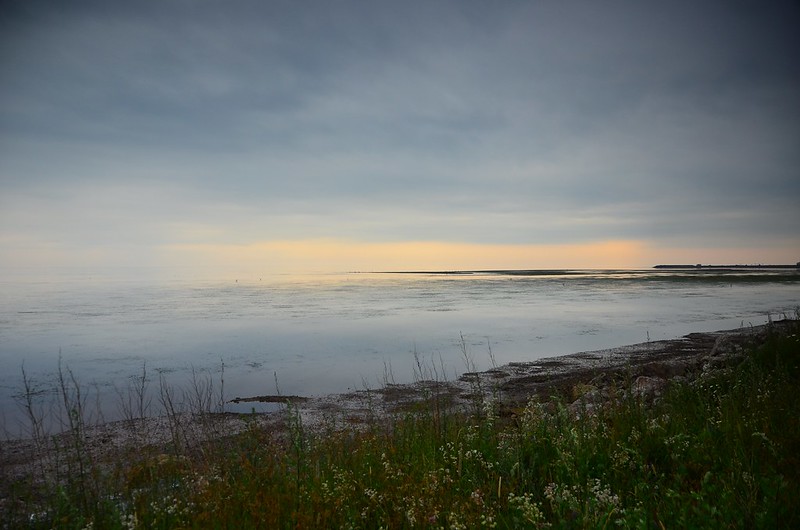
Percé is one of my favourite places in Canada, and it is with a feeling of slight regret that we left it that cloudy morning. The next two days would be spent mostly on the road, with much less time to slow down, stop and explore.
We stayed in Percé for as long as we could. Had a really late breakfast, enjoyed the views of the town from the hotel. Went down into town and had another one of those tasty lobster sandwiches on the shore of the gulf. Finally we geared up and continued going south on 132.
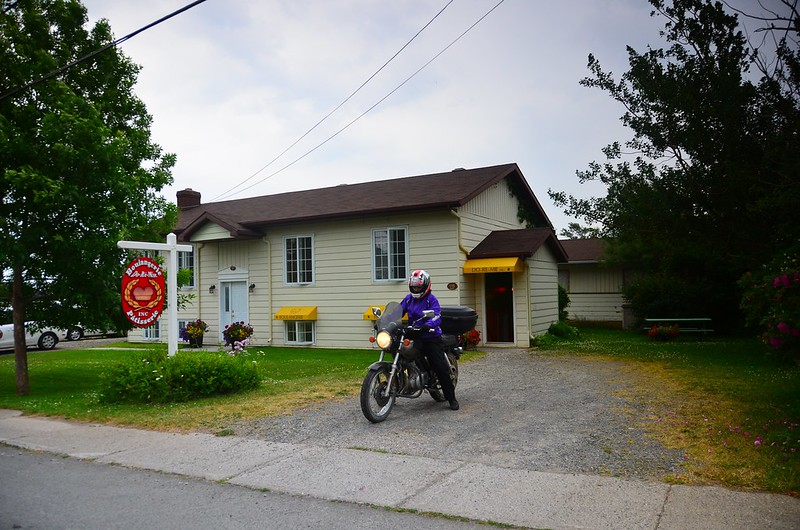
Boulangerie
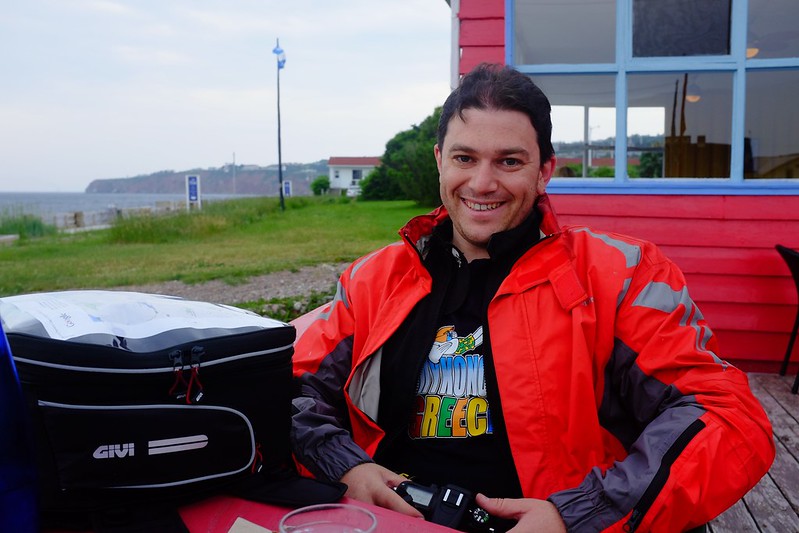

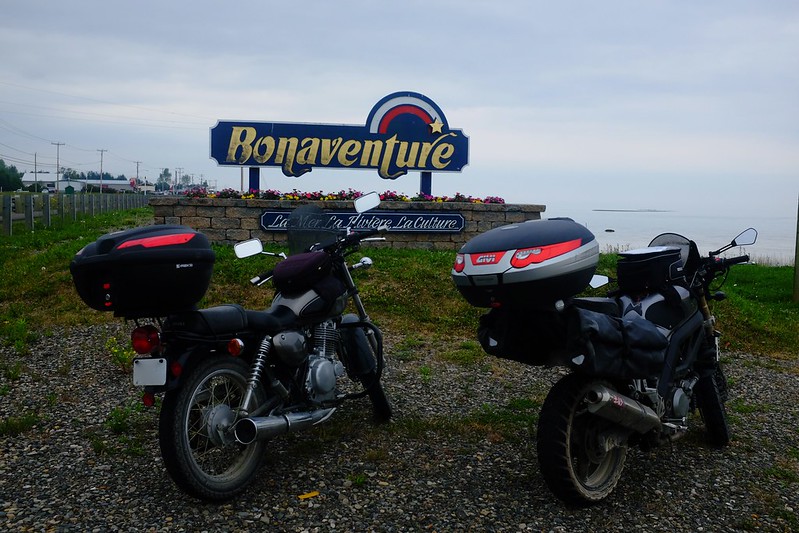
After a while of pretty curves on the shore we made our way to New Brunswick. From there we continued a little while along a major highway – 11. Needing gas we turned away from hwy 11 towards a small town. Finding a gas station was a little less trivial. The gas stations the GPS knew about were either closed or not gas stations at all. So we turned to follow the smaller hwy 134, which follows nearly parallel to 11 but closer to the shore and passing through small towns.
The area was Acadian and most street poles had a cool painted design to mimic the Acadian flag, and even the fire hydrants were decorated the same way. We stumbled upon an Esso station along the way (yey for the quick an easy speedpass payment, instead of the credit card that gets refused at the pump 50% of the time for no reason). After checking out more side roads along the Acadian route, we turned back to main freeways near Bathurst. It was getting to be late, and the skies were cloudy and menacing.
New Brunswick does not have its own police service and relies on RCMP, just like the rest of the Maritime provinces. Its highways are definitely unique. Main freeways like 8 and 11 are very straight, very smooth, and feel very remote. They are enclosed by deep forest all around, and whenever you come to any clearing, it’s to pass over a deep river valley, also enclosed within a forest with no civilization in sight. The road surface looked brand new and really tempted you to test out your speed on these roads, although I found that the strong winds detract a bit from your ability to reach your bike’s true capacity. It is here that I managed to pull the highest speed from my TU on this trip.
As it was getting darker we arrived in Miramichi, our stop for the night. The dinner at Boston Pizza was highlighted by mosquitos and bland food, and thus ended the day of our return to Anglophone Canada.
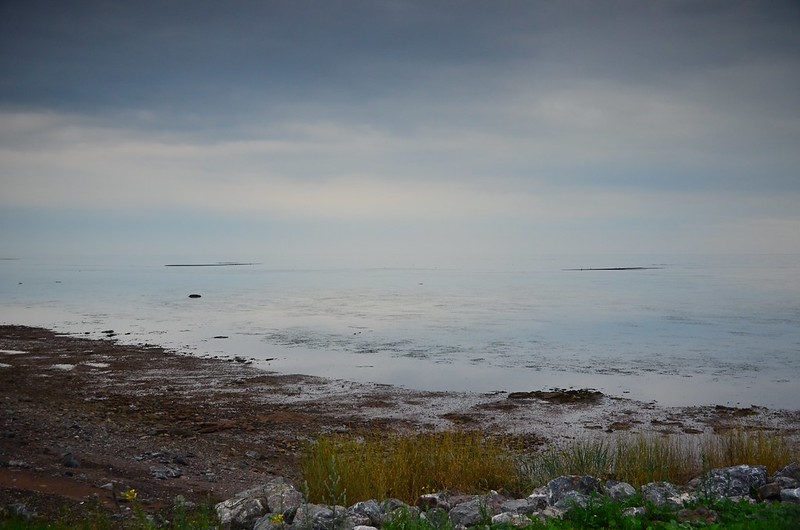

As there were not too many adventures this day, I’ll make a detour to discuss the more pragmatic things – the gear we got for the trip.
Aside from the typical things like luggage, there is also a question of electronic gadgets.
Communication
Prior to getting my TU I was riding pillion and we were using an iPhone app to communicate using Bluetooth. This worked well on a single bike, but the phone is not designed to allow high transmission power to Bluetooth so this method does not work with two bikes at anything above very low speeds / short distances. We decided to give Scala Rider devices a go and after trying their top of the line (but somewhat aged) G9 model, we promptly returned it and got a Q3 instead. Benefits: few buttons (fewer features too, but we did not miss any of them), lower cost, ability to use your own headphones. The last one is perhaps the most important, as this means you can use it with a set of good noise reducing in-ear headphones to cut the deafening high speed highway noise. Disadvantage: lower battery life. But there are ways to circumvent that, more on that later.
Cameras
Up until now the main workhorse in my photo stable was a Nikon D7000 with the 18-200mm VR lens. This thing can do it all and can do it fast. It’s a great setup, but it’s pretty heavy too. On an earlier 5 day long trip this year we tested out a Fuji X100s, a camera with similar (and sometimes superior) image quality, but smaller size and a bit less flexibility. It has a fixed lens, so not good for wildlife photos, unless wildlife is huge or does not mind you coming up really close and personal. Its smaller size and weight become a more pronounced advantage when you spend a lot of time walking around with the camera in tow – your neck does not hurt by the end of the day. The third camera was a Nikon D80 converted to shoot infrared. It’s very different and does not get out of the bag all that much, but the results are so unique, it’s worth it. A 10.5mm fisheye and a 50mm f/1.8 prime lenses rounded out this advanced line up. A pair of GoPros travelled in a category all of their own.
Power
Electricity is second only to gas on our trips. Installing a 12V adapter on my bike was one of the must haves on the list of mods to do before the trip, but that alone was not enough. It powered my Garmin GPS, while the adapter on the SV powered up an iPhone mounted in a Lifeproof case. (Great case by the way.) We needed something extra to make sure our communicators lasted through the long days of riding – a portable power source. After much deliberation we settled on a Powerocks Tetris AC Charge Pack. It’s a square block, about the size of a Macbook power brick, with 6000 mAh of juice available. The key features that made it a winner were:
- charging using a wall outlet and not a USB port. USB charging is slower, and provides no advantage when you don’t have a computer with you.
- folding prongs – no self respecting travel charger should have prongs stick out when not plugged in.
- dual USB output – so that both headsets can charge from a single device.
- good power capacity – sufficient to charge a Q3 headset at least 10 times over, or charge an iPhone twice
- availability – it was sold by Best Buy so we could easily return it if it sucked (did not have to 😉 )
With more than 1 device using USB to recharge (the GoPro cameras), my trick to avoid carrying too many USB adapters is to just take a small powered USB hub. 4 devices can charge from a single wall plug!
We would typically connect the headsets to the Powerocks charger while having lunch or any other break in riding, and it was sufficient most of the time. I think there were 3 times during entire trip when a headset would run out of power before the day was over, usually caused by taking too short of a lunch break 🙂 .
No Comments »
No comments yet.